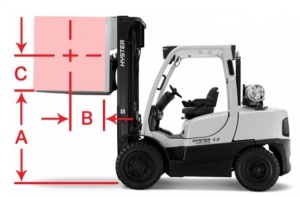Forklift feature articles
The largest forklift operator training website in the world
![]()
![]()

Vertical load centre on a forklift truck
This doesn't often get mentioned on a forklift operator training course but forklifts also have a vertical load centre as shown by the letter "C" above.
Obviously the letter "B" refers to the horizontal load centre as described on this page. The vertical load centre depends upon the size of the load and if we make the assumption that the forklift is carrying a 1000 mm cubic homogeneous load then the dimension "C" will be 500 mm.
From a forklift operator's point of view this can become important. As an example let's take a forklift fitted with a mast which will stack at 3,300 mm height maximum fork height. (I've chosen that because it's a common stacking height).
At maximum fork height the dimension vertically from the floor to the vertical centre of gravity of the load will be 3,300 plus 500 or 3,800 mm. This figure would have been taken into account by the forklift truck designers so no problems here.
What happens when the load is higher than 1000 mm? Again half the load's height has to be added to the maximum fork height but this time the dimension to the centre of gravity of the load is more than the designed dimension. This would cause the capacity of the forklift truck to be derated but such a deration would not be shown on the capacity plate which, of course, only shows dimensions to the top of the forks.
If you haven't read the section on stability testing the forklift truck you can go here to see what the affect of this higher dimension will have.